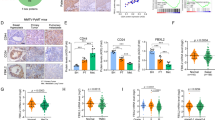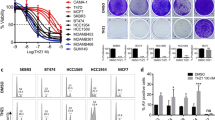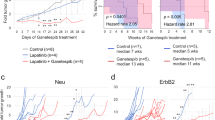Abstract
The development of acquired resistance to trastuzumab remains a prevalent challenge in the treatment of patients whose tumors express human epidermal growth factor 2 (HER2). We previously reported that HER2 overexpressing breast cancers are dependent on Y-box binding protein-1 (YB-1) for growth and survival. As YB-1 is also linked to drug resistance in other types of cancer, we address its possible role in trastuzumab insensitivity. Employing an in vivo model of acquired resistance, we demonstrate that resistant cell lines have elevated levels of P-YB-1S102 and its activating kinase P-RSK and these levels are sustained following trastuzumab treatment. Further, to demonstrate the importance of YB-1 in mediating drug resistance, the expression of the active mutant YB-1S102D rendered the BT474 cell line insensitive to trastuzumab. Questioning the role of tumor-initiating cells (TIC) and their ability to escape cancer therapies, we investigate YB-1's role in inducing the cancer stem cell marker CD44. Notably, the resistant cells express more CD44 mRNA and protein compared with BT474 cells, which correlated with increased mammosphere formation. Expression of YB-1S102D in the BT474 cells increase CD44 protein levels, resulting in enhanced mammosphere formation. Further, exposing BT474 cells to trastuzumab selected for a resistant sub-population enriched for CD44. Conversely, small intefering RNA inhibition of CD44 restored trastuzumab sensitivity in the resistant cell lines. Our findings provide insight on a novel mechanism employed by tumor cells to acquire the ability to escape the effects of trastuzumab and suggest that targeting YB-1 may overcome resistance by eliminating the unresponsive TIC population, rendering the cancer sensitive to therapy.
This is a preview of subscription content, access via your institution
Access options
Subscribe to this journal
Receive 50 print issues and online access
$259.00 per year
only $5.18 per issue
Buy this article
- Purchase on Springer Link
- Instant access to full article PDF
Prices may be subject to local taxes which are calculated during checkout




Similar content being viewed by others
References
Al-Hajj M, Wicha MS, Benito-Hernandez A, Morrison SJ, Clarke MF . (2003). Prospective identification of tumorigenic breast cancer cells. Proc Natl Acad Sci USA 100: 3983–3988.
Astanehe A, Finkbeiner MR, Hojabrpour P, To K, Fotovati A, Shadeo A et al. (2009). The transcriptional induction of PIK3CA in tumor cells is dependent on the oncoprotein Y-box binding protein-1. Oncogene 28: 2406–2418.
Bargou RC, Jurchott K, Wagener C, Bergmann S, Metzner S, Bommert K et al. (1997). Nuclear localization and increased levels of transcription factor YB-1 in primary human breast cancers are associated with intrinsic MDR1 gene expression. Nat Med 3: 447–450.
Cobleigh MA, Vogel CL, Tripathy D, Robert NJ, Scholl S, Fehrenbacher L et al. (1999). Multinational study of the efficacy and safety of humanized anti-HER2 monoclonal antibody in women who have HER2-overexpressing metastatic breast cancer that has progressed after chemotherapy for metastatic disease. J Clin Oncol 17: 2639–2648.
Finkbeiner MR, Astanehe A, To K, Fotovati A, Davies AH, Zhao Y et al. (2009). Profiling YB-1 target genes uncovers a new mechanism for MET receptor regulation in normal and malignant human mammary cells. Oncogene 28: 1421–1431.
Gluz O, Mengele K, Schmitt M, Kates R, Diallo-Danebrock R, Neff F et al. (2009). Y-box-binding protein YB-1 identifies high-risk patients with primary breast cancer benefiting from rapidly cycled tandem high-dose adjuvant chemotherapy. J Clin Oncol 27: 6144–6151.
Habibi G, Leung S, Law JH, Gelmon K, Masoudi H, Turbin D et al. (2008). Redefining prognostic factors for breast cancer: YB-1 is a stronger predictor of relapse and disease-specific survival than estrogen receptor or HER-2 across all tumor subtypes. Breast Cancer Res 10: R86.
Korkaya H, Paulson A, Iovino F, Wicha MS . (2008). HER2 regulates the mammary stem/progenitor cell population driving tumorigenesis and invasion. Oncogene 27: 6120–6130.
Lee C, Dhillon J, Wang MY, Gao Y, Hu K, Park E et al. (2008). Targeting YB-1 in HER-2 overexpressing breast cancer cells induces apoptosis via the mTOR/STAT3 pathway and suppresses tumor growth in mice. Cancer Res 68: 8661–8666.
Li X, Lewis MT, Huang J, Gutierrez C, Osborne CK, Wu MF et al. (2008). Intrinsic resistance of tumorigenic breast cancer cells to chemotherapy. J Natl Cancer Inst 100: 672–679.
Marangoni E, Lecomte N, Durand L, de Pinieux G, Decaudin D, Chomienne C et al. (2009). CD44 targeting reduces tumour growth and prevents post-chemotherapy relapse of human breast cancers xenografts. Br J Cancer 100: 918–922.
Ritter CA, Perez-Torres M, Rinehart C, Guix M, Dugger T, Engelman JA et al. (2007). Human breast cancer cells selected for resistance to trastuzumab in vivo overexpress epidermal growth factor receptor and ErbB ligands and remain dependent on the ErbB receptor network. Clin Cancer Res 13: 4909–4919.
Sawyers C . (2004). Targeted cancer therapy. Nature 432: 294–297.
Slamon DJ, Clark GM, Wong SG, Levin WJ, Ullrich A, McGuire WL . (1987). Human breast cancer: correlation of relapse and survival with amplification of the HER-2/neu oncogene. Science 235: 177–182.
Slamon DJ, Leyland-Jones B, Shak S, Fuchs H, Paton V, Bajamonde A et al. (2001). Use of chemotherapy plus a monoclonal antibody against HER2 for metastatic breast cancer that overexpresses HER2. N Engl J Med 344: 783–792.
Stratford AL, Fry CJ, Desilets C, Davies AH, Cho YY, Li Y et al. (2008). Y-box binding protein-1 serine 102 is a downstream target of p90 ribosomal S6 kinase in basal-like breast cancer cells. Breast Cancer Res 10: R99.
Stratford AL, Habibi G, Astanehe A, Jiang H, Hu K, Park E et al. (2007). Epidermal growth factor receptor (EGFR) is transcriptionally induced by the Y-box binding protein-1 (YB-1) and can be inhibited with iressa in basal-like breast cancer, providing a potential target for therapy. Breast Cancer Res 9: R61.
Sutherland BW, Kucab J, Wu J, Lee C, Cheang MC, Yorida E et al. (2005). Akt phosphorylates the Y-box binding protein 1 at Ser102 located in the cold shock domain and affects the anchorage-independent growth of breast cancer cells. Oncogene 24: 4281–4292.
To K, Fotovati A, Reipas K, Law JH, Hu K, Wang J et al. (2010). YB-1 induces expression of CD44 and CD49f leading to enhanced self-renewal, mammosphere growth, and drug resistance. Cancer Res 70: 2840–2851.
Vogel CL, Cobleigh MA, Tripathy D, Gutheil JC, Harris LN, Fehrenbacher L et al. (2002). Efficacy and safety of trastuzumab as a single agent in first-line treatment of HER2-overexpressing metastatic breast cancer. J Clin Oncol 20: 719–726.
Wu J, Lee C, Yokom D, Jiang H, Cheang MC, Yorida E et al. (2006). Disruption of the Y-box binding protein-1 results in suppression of the epidermal growth factor receptor and HER-2. Cancer Res 66: 4872–4879.
Acknowledgements
We thank Spencer Freeman from the Life Sciences Centre, UBC for his assistance with confocal microscopy. This work was supported by the Canadian Breast Cancer Research Alliance and the National Cancer Institute of Canada (SED). JD was a recipient of the Child and Family Research Institute Graduate Studentship and AA was a recipient of Canadian Institute of Health Research MD/PhD and the Michael Smith Foundation for Health Research Studentships.
Author information
Authors and Affiliations
Corresponding author
Ethics declarations
Competing interests
The authors declare no conflict of interest.
Additional information
Supplementary Information accompanies the paper on the Oncogene website
Rights and permissions
About this article
Cite this article
Dhillon, J., Astanehe, A., Lee, C. et al. The expression of activated Y-box binding protein-1 serine 102 mediates trastuzumab resistance in breast cancer cells by increasing CD44+ cells. Oncogene 29, 6294–6300 (2010). https://doi.org/10.1038/onc.2010.365
Received:
Revised:
Accepted:
Published:
Issue Date:
DOI: https://doi.org/10.1038/onc.2010.365
Keywords
This article is cited by
-
Upregulated PARP1 confers breast cancer resistance to CDK4/6 inhibitors via YB-1 phosphorylation
Experimental Hematology & Oncology (2023)
-
The WAVE3/β-catenin oncogenic signaling regulates chemoresistance in triple negative breast cancer
Breast Cancer Research (2023)
-
Holistic anti-tumor resistance mechanism of YBX1 and its potential as a chemoresistance target in pancreatic ductal adenocarcinoma
Holistic Integrative Oncology (2023)
-
Response to trastuzumab and investigation of expression profiles of matrix metalloproteinase-related proteins in primary breast cancer stem cells
Clinical and Experimental Medicine (2021)
-
Altered transcriptional regulatory proteins in glioblastoma and YBX1 as a potential regulator of tumor invasion
Scientific Reports (2019)



